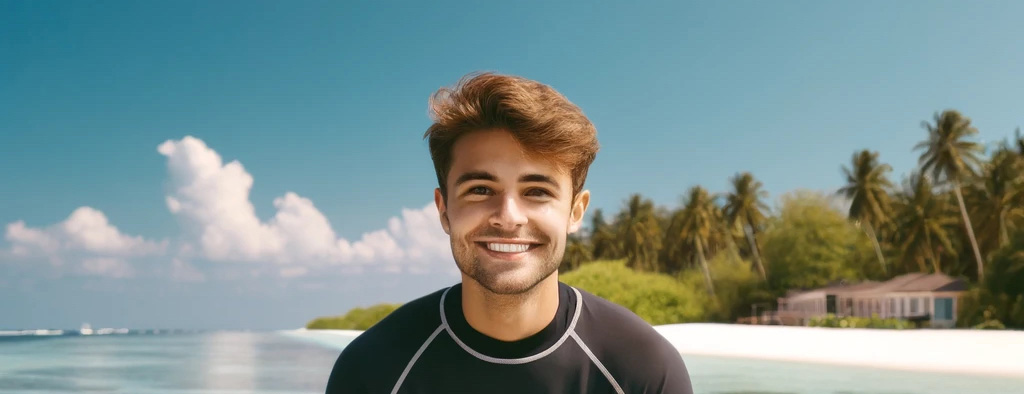
A diver’s mass is not always constant. It can increase or decrease based on certain movements, the amount gas in the BCD and lung volume.
Therefore, it is important for a diver to learn and optimize correct movements based on these changing conditions.
Hands and arms
Like all other actions while diving, it is recommended to think about and visualize the movement you’re going to do, before you actually do it. Think through the movement from beginning to end. Consider your center of gravity, and think about the potential consequences of making the movement under water.
Remember Newton’s Third Law of Motion, which essentially states that for every action there is an equal, and opposite reaction. For example, an overly powerful upward arm movement will force the diver to have to correct himself; thus, causing the diver to expend more energy than necessary. It is difficult to be precise with arm movements under water, which leads to wasted energy. For this reason, it’s recommended to restrict arm movements to minimal balance and pitch corrections only.
As with buoyancy control, practice hand and arm movements while in a controlled underwater environment. Doing so will help your mind and body anticipate what actions to perform, and what outcome to expect based on various buoyancy characteristics.
As the diver’s gain the experience and ability to manage their buoyancy and position in the water also increases, the use of the hands and movement decreases. At the end of your SNSI Advanced Open Water Diver training, you will be able to perform the entire dive with minimal hand and arm movements.
Legs, Feet, and Fins
The best type of kick to use when diving depends on the diver’s ability, the location of the dive, the diver’s surroundings, and the diver’s intended speed.
In many cases, a recreational diver’s dive plan focuses on viewing the sea floor and its inhabitants. In this circumstance, the flutter kick is often not the best kick to use as it may disturb the bottom, or damage sea life.
The frog kick is always a good option when trying to avoid kicking the bottom, yet maintain controlled propulsion. Performing the frog kick keeps the diver’s legs on the same plane as his body and displaces the water sideways and behind the diver. This kick also increases the diver’s surface area, making him more stable.
Sideways finning is a technique that can be used when moving through small passages and caverns. This technique is basically swimming on one’s side, to help prevent blowback, or silt out from stirring the sea floor.
Techniques such as this can be combined with other propulsion skills to tailor movement for specific circumstances in order to prevent clouding the water or damaging static sea creatures.
In situations where the diver has limited leg mobility, but must maintain a central center of gravity, he has the option to use his lower leg muscles to rotate his ankles in conjunction with a slight sideways motion. This provides the diver with needed propulsion while horizontal, with little risk of contacting objects or sea life, especially when near a reef wall or the sea floor.
The SNSI Master & Buoyancy Diver video and your SNSI Instructor will demonstrate this technique and help you implement the skill into your buoyancy control practice.
The combination of controlled movements of the hands, arms, legs and fins allows a diver to develop specialized techniques to maintain buoyancy control in unique situations and positions.
After becoming comfortable with each technique, you will learn how and when to combine them for optimal buoyancy control in any situation.
Combining your breathing, BCD usage and strategic movements will enable you to become more efficient, use less gas, and be more relaxed under water.
THE Trim
In the last decade, the term “Trim” has become very popular in the diving world. However, it should not be confused with the ability to control buoyancy; The Trim is the achievement, by the diver, of a perfect horizontal position that minimizes the resistance of the water as the diver swims through it.
The angle of the diver’s body with respect to the horizontal plane in the horizontal direction represents his Trim, in the transverse direction his Balance.
The main factors that influence these two elements and which we can easily modify are:
amount and distribution of the weights;
cylinder positioning;
slow, controlled breathing;
shape and size of the BCD;
well-arranged and a fixed suitable equipment and accessories;
body posture.
Our position certainly plays a decisive role in all of this. Here are some tricks that can help us maintain a position that minimizes excessive angles to maintain balance and trim:
body stretched from chest to knees;
bent knees and horizontal fins to increase stability;
feet (and fins) should be the highest part of our body;
arms in front of the body.
This type of position is undoubtedly preferred in the advance phase, but it is certainly not the best nor most comfortable position for all phases of the dive.
As soon as the descent has started, it is preferable to maintain a slightly more vertical position to facilitate the air exhaust from the BCD (and dry suit if one is in use), and above all to facilitate the compensation of the ears and paranasal sinuses, especially in the first few feet/meters where the volume variation is greater.
The same consideration can also be made in the ascent phase when it is necessary to empty the BCD (and the dry suit).